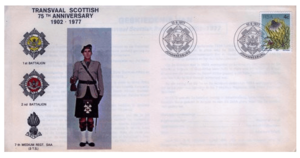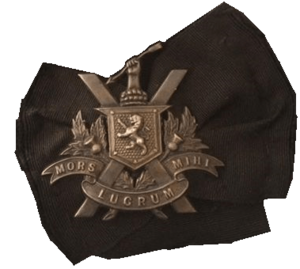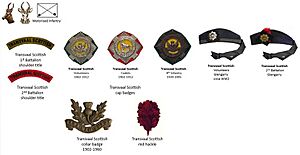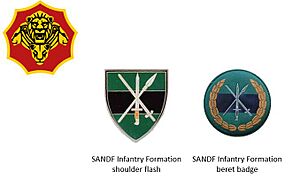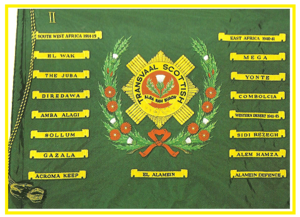Solomon Mahlangu Regiment facts for kids
Quick facts for kids Transvaal Scottish VolunteersTransvaal Scottish Solomon Mahlangu Regiment |
|
|---|---|
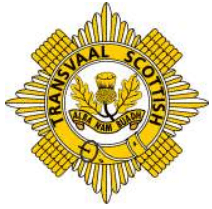
SANDF Transvaal Scottish emblem
|
|
| Active | 1902 to present |
| Country | |
| Allegiance |
|
| Branch |
|
| Type | Line infantry |
| Role | Motorised infantry |
| Size | One battalion |
| Part of |
|
| Garrison/HQ | The View, Parktown Johannesburg |
| Motto(s) | Alba nam Buadh (Scotland, Home of the Virtues) |
| March | The Atholl Highlanders |
| Insignia | |
| Company level Insignia |  |
| SA Motorised Infantry beret bar circa 1992 | |
| Abbreviation | SMR |
The Solomon Mahlangu Regiment is a special group of soldiers in the South African Army. They are a 'reserve' unit, which means their members are not full-time soldiers. Instead, they are called upon when needed. This regiment used to be known as the Transvaal Scottish.
Contents
The Regiment's Story
How It Started
The regiment was created in 1902 by John Murray, Marquis of Tullibardine. This was right after the Second Boer War ended. Many Scottish soldiers who fought in the war decided to stay in South Africa. They became the first members of this new unit.
The regiment wore the Murray family's special tartan pattern. It was a very large unit with groups of soldiers in many big towns across the Transvaal Province.
Early Challenges: Rebellions
The unit first saw action during the Bambatha Rebellion. This happened in 1906. A group of soldiers from the Transvaal Scottish joined another unit called the Natal Rangers.
In 1914, the regiment was called up again during the Maritz Rebellion. This was when some people who wanted to bring back the old Boer Republic fought against the new government of the Union of South Africa. The regiment took part in these events.
Fighting in World War I
Battles in South West Africa
When First World War started, the Transvaal Scottish helped invade German South West Africa. This happened in late 1914. A second group, called the 2nd Transvaal Scottish, was formed for this mission.
Their toughest fight was near Trekkoppies. A larger German force attacked the 2nd Battalion. The regiment had its first casualties of the war there. Two soldiers were killed and 13 were wounded. After South West Africa was taken, the 2nd Battalion was disbanded. The 1st Transvaal Scottish stayed in reserve for the rest of the war.
On the Western Front
To help the British forces in Europe, a new unit was created. It was called the 4th South African Infantry Regiment. It was also known as the South African Scottish. This was because a law from 1912 stopped regular South African soldiers from fighting outside the country. This new unit wore kilts with the Murray of Atholl tartan. Many members came from the Transvaal Scottish.
After a short fight in North Africa in 1915, the SA Scottish went to France. There, they fought in the terrible Battle of Delville Wood in 1916. This battle was part of the larger Battle of the Somme. Between July 15 and 19, 1916, 74% of the soldiers who fought were killed or wounded. By the end of July, the South African Scottish had lost 868 soldiers.
After Delville Wood, the SA Scottish unit was rebuilt. They continued to serve on the Western Front. They fought in places like Vimy Ridge, Passchendaele, and Messines.
In East Africa
Other members of the Transvaal Scottish also fought in the East African Campaign. After the war ended, the soldiers returned home and went back to their normal lives.
Between the World Wars
In 1922, the Transvaal Scottish were called up again. They helped keep order during the Rand Rebellion. This was an armed uprising by miners. In one fight near Boksburg, 12 members of the regiment were killed. The regiment helped clear the last rebels from Fordsburg on March 14, 1922. In total, 5 more soldiers died and 60 were wounded during this revolt.
Fighting in World War II
In 1936, a second battalion was formed. When World War II began in 1939, a third battalion was also created.
The 1st Transvaal Scottish fought in the East African Campaign. They helped take Italian East Africa. They fought Italian forces in places like Addis Ababa and Amba Alagi. The battalion then went to Egypt to help in the Siege of Tobruk. In November 1941, the 1st Transvaal Scottish successfully fought off a strong German attack.
In 1942, during the Battle of Gazala, the 1st battalion defended against many attacks. They then joined the retreat to the Alamein Line in Egypt. Some soldiers were captured at Tobruk in June 1942. The 1st Transvaal Scottish then joined the British Eighth Army in the Second Battle of El Alamein. They stopped the German attack on Egypt. In early 1943, the battalion returned to South Africa. There, it became an armoured unit.
In North Africa, the 2nd Transvaal Scottish helped build the famous "Alamein Box." They attacked Sollum in January 1942. They also fought in the battles of Bardia, Acroma Keep, and Gazala. At Bardia, Sollum, and Halfaya, German and Italian troops surrendered to them. Most of the battalion was captured when Tobruk fell.
The 3rd Transvaal Scottish fought in the East African Campaign in Ethiopia. They took part in a three-day attack on Mega, Ethiopia. After this, the battalion went to Egypt. They suffered heavy losses in the battle of Sidi Rezegh in November 1941. After Sidi Rezegh, the 3rd Transvaal Scottish was temporarily disbanded. More than 200 members of the Transvaal Scottish died in World War II.
Some members of the 3rd Transvaal Scottish were captured in North Africa. They were sent to Europe. Some were on a ship called Sebastiano Veniero when a British submarine sank it in December 1941. The ship's crew managed to get the ship to shore. Many prisoners of war (PoWs) tried to swim to safety. A soldier named Bernard Friedlander swam ashore with a rope. This took him 90 minutes. The rope was then used to help nearly 1,600 survivors reach safety. In 1945, Friedlander was given the George Medal for his bravery.
After World War II (1945-1974)
All three battalions were brought back in 1946. The 3rd battalion became an artillery unit. This unit was disbanded in 1959. Many of its members returned to the Transvaal Scottish. In 1953, the 1st and 2nd battalions joined together. However, in 1971, the 2nd Battalion Transvaal Scottish was started again.
South African Border War
After Portugal left Angola in 1975, a Civil War started there. The 1st Battalion Transvaal Scottish was sent to southern Angola from South-West Africa. Later that year, the 2nd Battalion went to the Caprivi Strip. They helped develop new ways of fighting using special vehicles.
In 1983, Company Sergeant-Major Trevor Wright was given the Honoris Crux. This was for his bravery when his base was attacked by armed fighters. Wright personally fired a machine gun and made sure there was enough ammunition. Two years before, Wright had also risked his life. He picked up a live hand grenade that had been accidentally dropped near his fellow soldiers during training and threw it away.
In the 1980s, the 2nd Transvaal Scottish became the first reserve unit to be sent to the borders with Botswana and Zimbabwe.
The 1990s and Beyond
In the early 1990s, when talks to end apartheid in South Africa were happening, the 1st and 2nd Transvaal Scottish helped keep peace. They were sent to townships where there was unrest.
The regiment's last major duty was to be ready during South Africa's first democratic elections on April 27, 1994. The Transvaal Scottish helped ensure a peaceful change to democracy. In 1997, the 1st and 2nd Battalions joined together again.
In 1995, a group from the Transvaal Scottish visited the battlefields in France. They also visited their former Colonel-in-Chief, Queen Elizabeth the Queen Mother. They also saw their allied regiment, The Black Watch, and the Atholl Highlanders in Scotland.
In 2000, the regiment took part in a parade in London for Queen Elizabeth the Queen Mother's 100th birthday. In 2002, they returned for her funeral. In 2002, the regiment celebrated 100 years of service. They had a special parade at King Edward VII School in Johannesburg.
Since 2007, members of the regiment have helped in United Nations peacekeeping missions. They have served in Burundi and the Democratic Republic of Congo. In 2010, a company from the Transvaal Scottish was sent to the United Nations Mission in Sudan. Another company helped defend South Africa's borders.
The regiment's main office is now at The View, Parktown. This building was once the home of Sir Thomas Cullinan.
New Name for the Regiment
In August 2019, many reserve units had their names changed. This was to reflect the history of African military groups and the armies that fought for freedom. The Transvaal Scottish became the Solomon Mahlangu Regiment. They have three years to create new symbols for the regiment.
Regimental Symbols and Traditions
- The regiment's special fabric pattern, called a tartan, is the "Murray of Atholl." However, the pipers wear the "Murray of Tullibardine." Both tartans show the regiment's link to the Dukes of Atholl. Since 1938, members have worn a red feather on their hats. This shows their connection to the famous Black Watch Regiment. For formal events, officers carry special swords called Basket-hilted claymores.
- The regiment's badge shows a Scottish thistle. It has a scroll with the motto Alba nam Buadh. This is Scottish Gaelic for "Well done, Scotland" or "Scotland, home of the virtues." The badge is surrounded by a strap with the regiment's name. All of this is on the Star of the Order of the Thistle.
- The regiment's official march tune is "The Atholl Highlanders."
Old Dress Symbols
During World War I, the 4th Infantry Regiment was formed. It was unique because it was the South African Scottish. It was made up of soldiers from the Transvaal Scottish and the Cape Town Highlanders. They wore the Atholl Murray tartan.
Current Dress Symbols
Allied Regiments
The Solomon Mahlangu Regiment has special connections with other military units:
 United Kingdom - Black Watch
United Kingdom - Black Watch Scotland - The Atholl Highlanders
Scotland - The Atholl Highlanders United Kingdom - Fife and Forfar Yeomanry/Scottish Horse
United Kingdom - Fife and Forfar Yeomanry/Scottish Horse
Sister Regiments
The 3rd Battalion Transvaal Scottish was changed into the 7 Medium Artillery Regiment. It was based in Benoni.
Battle Honours
The Transvaal Scottish has received many special awards called "battle honours" for their bravery in fights. These are displayed on their regimental flags:
- Natal 1906
- South West Africa, 1914-1915
- East Africa (1940-1941)
- El Wak
- The Juba
- Yonte
- Diredawa
- Combolcia
- Amba Alagi
- Western Desert (1941-1943)
- Sollum
- Sidi Rezegh
- Gazala
- Alem Hamza
- Acroma Keep
- Alamein Defence
- Mega
- El Alamein
| Battle Honours awarded to the Transvaal Scottish |
|---|
The regiment also claims 15 "missing" battle honours. These were awarded to the 4th South African Infantry (South African Scottish) battalion for their service in France. These include some of the most famous battles in South African military history: Egypt 1916, Somme 1916, Delville Wood, Arras 1917, Ypres 1917, Menin Road, Messines 1918, Hindenburg Line, Cambrai 1918, Pursuit to Mons, France and Flanders 1918, Le Transloy, Scarpe 1917, Kemmel, Lys
| Missing Awards |
|---|
Pipes & Drums Band
The regiment has a special band with bagpipes and drums. This is because of their Scottish heritage. The band was formed in 1902. It is one of only three such bands in the South African Defence Force.
The band is often called the ‘Jocks’. They have won the top pipe band championships in South Africa many times. In 2019, they were crowned South African Champions.
The drummers wear the Murray of Atholl tartan, which is the regiment's main tartan. The pipers wear the Murray of Tullibardine tartan. The exciting regimental march, "The Atholl Highlanders," is a key part of their music. When this tune is played, all current and former members of the regiment stand to attention.
The Pipes and Drums are led by Pipe Major Craig Whitley and Drum Major Anthony Evans.
Freedom of Entry
On November 9, 2013, the unit marched through Johannesburg. This was part of the city's 100-year celebration. They marched with bayonets fixed, flags flying, and drums beating. This special event is called "Freedom of Entry."




